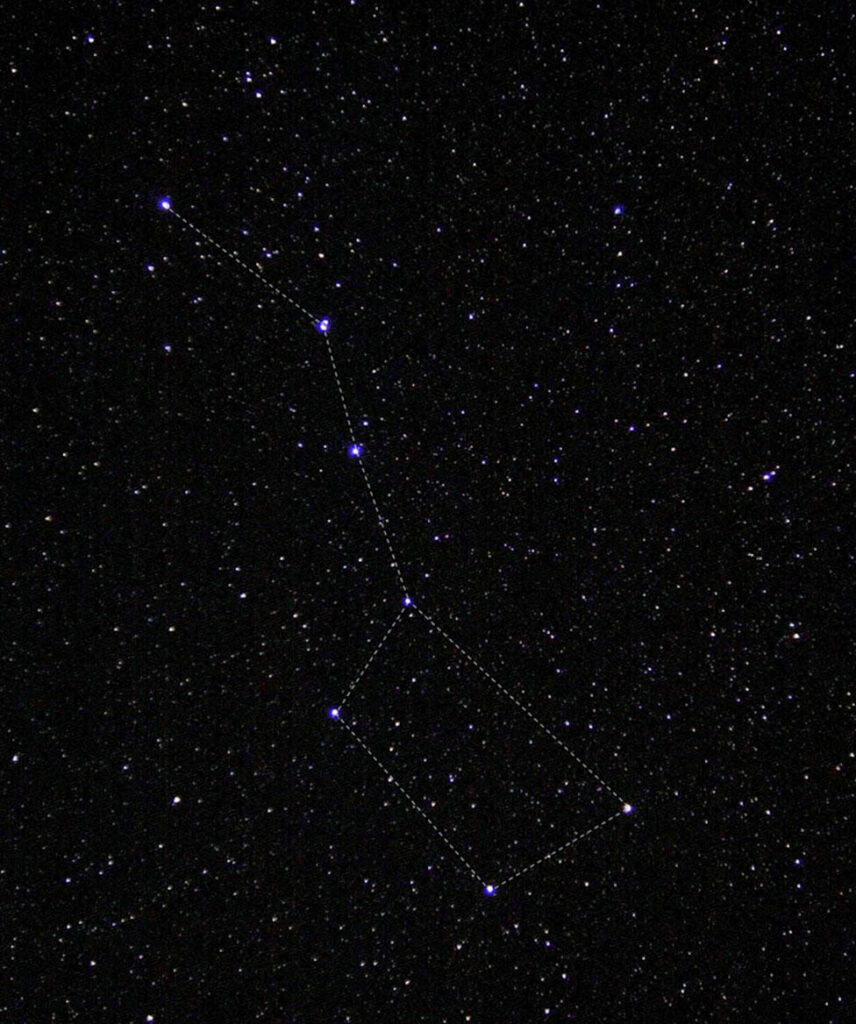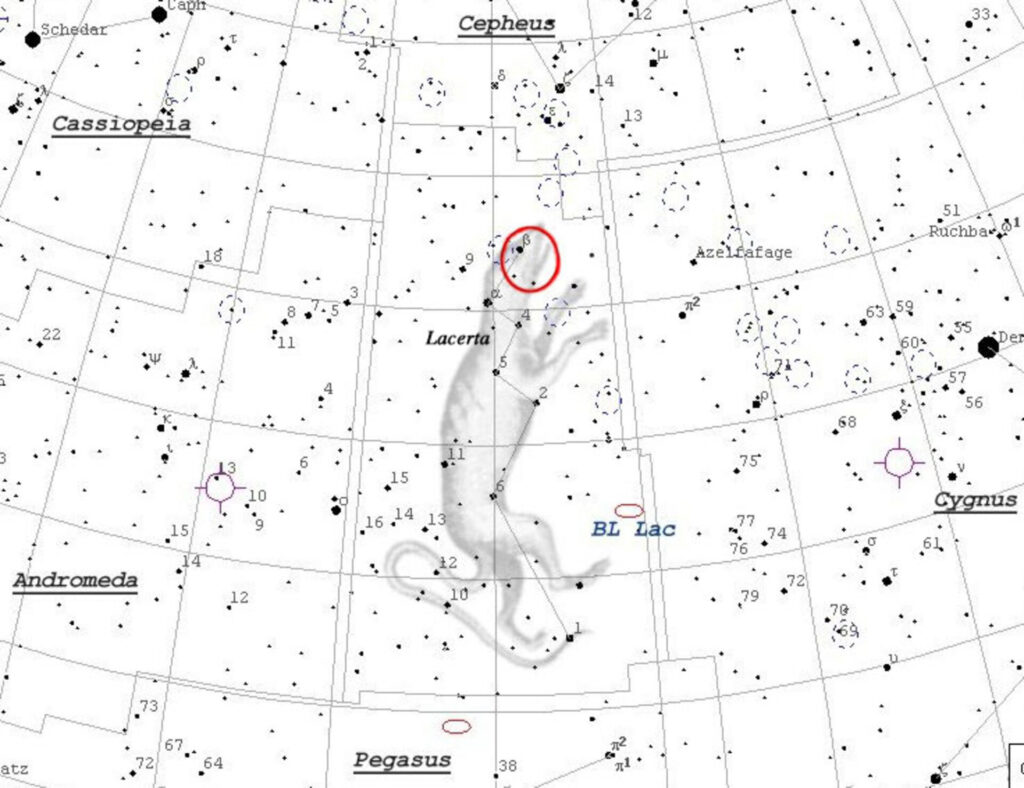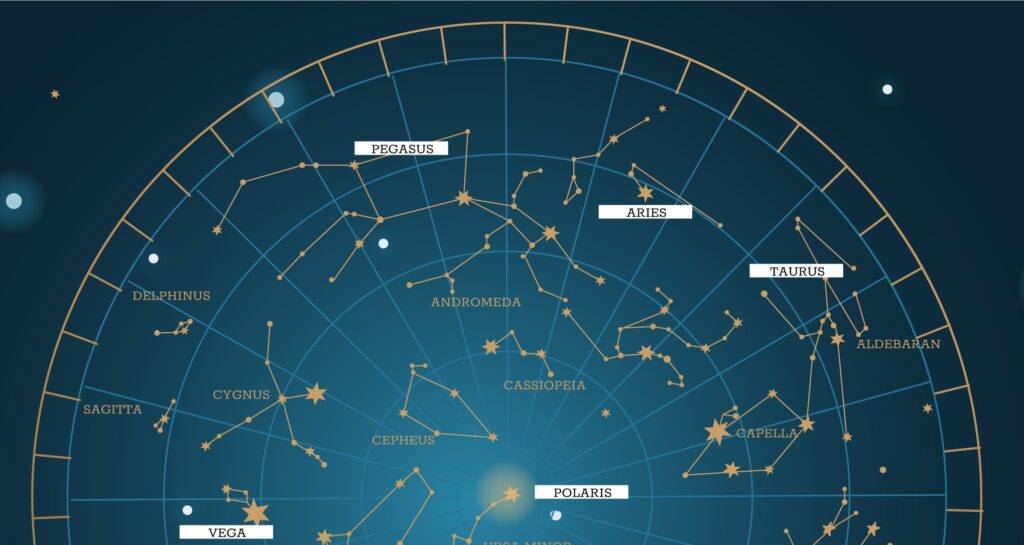Navigating the Night Sky
© freepik/wirestock
Table of Contents
A constellation is an area on the celestial sphere in which a group of visible stars forms a perceived pattern or outline, typically representing an animal, mythological subject, or inanimate object.
The origins of the earliest constellations likely go back to prehistory. People used them to relate stories of their beliefs, experiences, creation, or mythology. Different cultures and countries invented their own constellations, some of which lasted into the early 20th century before today’s constellations were internationally recognized. The recognition of constellation has changed significantly over time. Many changed in size or shape. Some became popular, only to drop into obscurity. Some were limited to a single culture or nation. Naming constellations also helped astronomers and navigators identify stars more easily.
There are 88 officially recognized constellations by the International Astronomical Union (IAU), and they encompass the entire celestial sphere, dividing the night sky into defined regions. Some are well-known and easily recognizable, such as Orion, Ursa Major (which contains the Big Dipper), and Cassiopeia. Others are more obscure and less familiar. In 1928 adopted official constellation boundaries that together cover the entire celestial sphere.
Any given point in a celestial coordinate system lies in one of the modern constellations. Some astronomical naming systems include the constellation where a given celestial object is found to convey its approximate location in the sky. The Flamsteed designation of a star, for example, consists of a number and the genitive form of the constellation’s name.
It’s important to note that constellations are not actual physical groupings of stars, but rather a product of human perception from our vantage point on Earth. The stars in a constellation may be vastly distant from each other in reality, but they appear to form a connected pattern when observed from our planet.
TYPES OF CONSTELLATIONS

Constellations are classified into three separate categories based on when they can be seen during the year as well as what celestial objects move through the stars. Circumpolar constellations are ones that are seen all year round. Their shapes lie close to the north celestial pole and do not set below the horizon. Whereas, zodiacal constellations are ones in which the Sun passes through. This is where the origin of the signs of the zodiac came from. And lastly, seasonal constellations are ones that change throughout the year depending on the seasons. For example, in the northern hemisphere, the constellation Orion is seen during the winter months. The constellation Scorpius is one you see during the summer months.
CIRCUMPOLAR CONSTELLATION
Circumpolar constellations are stellar formations that, from a specific observer’s viewpoint, never set below the horizon. They appear to revolve around either the north or south celestial pole, depending on the observer’s location in the Northern or Southern Hemisphere. In the Northern Hemisphere, Ursa Major, Ursa Minor, and Cassiopeia are examples of well-known circumpolar constellations. Conversely, in the Southern Hemisphere, constellations like Crux and Centaurus remain visible throughout the entire night.
Due to their perpetual presence in the sky, circumpolar constellations have played significant roles in various cultures’ mythology, navigation, and timekeeping systems. They are particularly useful for orientation in regions near the Earth‘s poles, where conventional constellations rise and set quickly. Observers at high latitudes can spot them year-round, making them essential reference points for both amateur and professional astronomers.
ZODIACAL CONSTELLATION
Zodiacal constellations lie along the plane of the ecliptic, the apparent path the Sun traces through the sky over the course of a year. There are twelve zodiacal constellations, each corresponding to a specific astrological sign. Zodiacal include Aries, Taurus, Gemini, Cancer, Leo, Virgo, Libra, Scorpius (often referred to as Scorpio), Sagittarius, Capricornus (often referred to as Capricorn), Aquarius, and Pisces.
They hold cultural and astrological significance, with each sign associated with certain personality traits and characteristics in astrology. However, it’s important to note that in astronomical terms, the zodiacal are not evenly spaced along the ecliptic, and the Sun spends varying amounts of time in each constellation due to the Earth’s axial tilt.
The zodiacal constellations serve as important reference points for astronomers and skywatchers alike. They help in locating celestial objects and tracking the positions of planets, as they generally lie within the Sun’s apparent path across the sky. They have been observed and studied for centuries, contributing to our understanding of celestial motion and the Earth’s position in the solar system.
SEASONAL CONSTELLATION
Seasonal constellations are groups of stars that are visible in the night sky during specific times of the year due to the Earth’s orbit around the Sun. Unlike circumpolar, which are visible year-round from a certain location, seasonal constellations come into view for a period and then disappear below the horizon as the Earth continues its orbit.
Understanding seasonal constellations allows astronomers and stargazers to track the changing night sky throughout the year. It also helps in identifying the best times to observe specific celestial objects, such as planets, star clusters, and galaxies, as they move through different constellation.
NORTHERN CONSTELLATION
Northern constellations are groups of stars that are visible from the Northern Hemisphere of the Earth. They appear to revolve around the North Star, Polaris, which is located very close to the North Celestial Pole. As a result, they are visible throughout the year, albeit with some variations in visibility depending on the season.
Prominent northern constellations include Ursa Major (home to the Big Dipper), Ursa Minor (home to the Little Dipper and Polaris), Cassiopeia, Draco, and Cygnus, among others. They are familiar to observers in the Northern Hemisphere and play a significant role in various cultures’ mythologies and navigation.
Northern constellation provide a reference point for stargazing and celestial navigation. For instance, the Big Dipper’s shape is easily recognizable and its pointers can be used to locate the North Star, aiding in finding direction in the night sky.
While visible year-round, the specific arrangement and visibility of northern constellations change with the seasons. Some may be more prominent in certain months or appear at different times of the night.
SOUTHERN CONSTELLATION
Southern constellations are groups of stars that are primarily visible from the Southern Hemisphere of the Earth. They appear to revolve around the South Celestial Pole, which lacks a bright star like Polaris in the North. This makes it more challenging to identify a specific “South Star.”
Prominent southern constellations include the Southern Cross (Crux), Centaurus, Scorpius, and the Magellanic Clouds. They are well-known to observers in the Southern Hemisphere and play significant roles in the astronomy and cultures of southern-latitude regions.
Southern constellation provide unique perspectives on the night sky and contain many fascinating celestial objects. For example, the Southern Cross is a distinctive and easily recognizable shape in the southern sky. Due to the Earth’s rotation, southern constellations change position and visibility throughout the night. Some are more visible during specific seasons, while others may be prominent year-round.
UNIQUE CONSTELLATIONS

While many constellations are widely recognized, several unique constellations hold special significance in various cultures or possess distinctive characteristics. Here are some noteworthy examples:
- Lacerta (The Lizard): Lacerta is a small, inconspicuous constellation located in the northern hemisphere. It was introduced by the Polish astronomer Johannes Hevelius in the 17th century and represents a lizard.
- Musca (The Fly): Musca is a small southern hemisphere constellation that was first introduced by the Dutch astronomer Petrus Plancius in the late 16th century. It is notable for being one of the few constellation that represents an insect.
- Hydrus (The Water Snake): Hydrus is a small southern hemisphere constellation that represents a water snake. It was introduced by the Dutch astronomer Petrus Plancius and was later included in Johann Bayer’s star atlas Uranometria.
- Indus (The Indian): Indus is a faint southern hemisphere constellation representing a Native American. It was introduced by the Dutch astronomer Petrus Plancius in the late 16th century.
- Sagitta (The Arrow): Sagitta is a small, unassuming constellation representing an arrow. It is one of the 48 constellations listed by the 2nd-century astronomer Ptolemy and is located in the northern hemisphere.
- Vulpecula (The Little Fox): Vulpecula is a faint constellation located in the northern hemisphere. It was introduced by the Polish astronomer Johannes Hevelius in the 17th century and represents a fox.
- Microscopium (The Microscope): Microscopium is a small southern hemisphere constellation that was introduced by the French astronomer Nicolas-Louis de Lacaille in the 18th century. It represents a microscope.
- Telescopium (The Telescope): Telescopium is a southern hemisphere constellation also introduced by Nicolas-Louis de Lacaille. As the name suggests, it represents a telescope.
- Norma (The Carpenter’s Square): Norma is a small, inconspicuous constellation located in the southern hemisphere. It was introduced by Nicolas-Louis de Lacaille and represents a carpenter’s square.
- Phoenix: Phoenix is a southern hemisphere constellation representing a mythical bird associated with rebirth and regeneration. It was introduced by the Dutch astronomer Petrus Plancius.
NAVIGATIONAL ROLE

Constellations have played a crucial navigational role throughout human history. They served as natural guides for early explorers, aiding in navigation across oceans, deserts, and unfamiliar territories.
- Celestial Navigation: Constellations were used by ancient mariners as a means of celestial navigation. By observing the positions of stars and constellations, sailors could determine their latitude and approximate longitude, allowing them to plot their course.
- Orientation and Direction: Constellations provided fixed reference points in the night sky, aiding travellers in determining their orientation and the direction of their journey. For example, the North Star (Polaris) has been a crucial reference point for navigators in the Northern Hemisphere.
- Seasonal Changes: The positions of constellations change over the course of a year due to Earth’s orbit around the Sun. This provided early navigators with a way to track the passage of time and seasons, helping them plan journeys and agricultural activities.
- Cross-Cultural Significance: Many ancient cultures developed their own constellations, often with mythological or cultural significance. These celestial patterns served as mnemonic devices, helping people remember important stories, traditions, and navigational cues.
- Wayfinding in Deserts and Wilderness: In land-based navigation, constellations were essential for desert nomads, explorers, and traders. They provided a reliable means of orienting themselves in vast, featureless landscapes.
- Long-Distance Exploration: During long sea voyages or overland journeys, constellations were a critical tool for maintaining course and avoiding getting lost. Navigators would use star charts, astrolabes, and other tools to identify and track constellations.
- Modern Applications: While advanced technology like GPS has largely replaced traditional celestial navigation in modern times, knowledge of constellations still holds value. It can serve as a backup method in case of technological failure, and it remains an important skill for astronomers, pilots, and certain military applications.
DARK CLOUD CONSTELLATION

The Great Rift, a series of dark patches in the Milky Way, is more visible and striking in the southern hemisphere than in the northern. It vividly stands out when conditions are otherwise so dark that the Milky Way’s central region casts shadows on the ground.
Some cultures have discerned shapes in these patches and have given names to these “dark cloud constellations”. Members of the Inca civilization identified various dark areas or dark nebulae in the Milky Way as animals and associated their appearance with the seasonal rains. Australian Aboriginal astronomy also describes dark cloud constellations, the most famous being the “emu in the sky” whose head is formed by the Coalsack, a dark nebula, instead of the stars.
